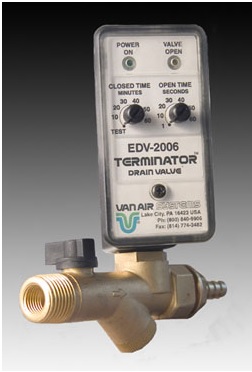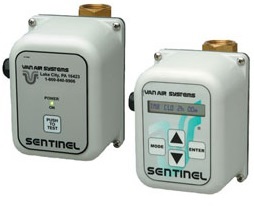Troubleshooting Guide: Common Issues with Automati…
Posted by AVP on Dec 6th 2023
When you think of a humming workshop, you’ll often recognize the steady hiss of compressed air, and then suddenly, an unexpected drip.
For those relying on automatic drain valves to keep their compressed air systems in peak condition, such an occurrence can be perplexing. But there’s no need to worry, because in this troubleshooting guide we’ll cover the common issues with automatic drain valves and provide straightforward solutions for seamless operation.
Understanding Condensate Buildup
Condensate, the often overlooked byproduct of compressed air systems, plays a pivotal role in their performance.
When air is compressed, it heats up, carrying moisture vapor. As this air cools downstream, the moisture condenses into liquid form, creating condensate. This water, if not adequately managed, can lead to a cascade of issues.
1. Mechanics of Condensate Formation:
Understanding the science behind condensate buildup involves grasping the principles of temperature and humidity.
When compressed air reaches its dew point, the temperature at which it can no longer hold moisture, condensation occurs. This phenomenon can be exacerbated in environments with fluctuating temperatures and humidity levels.
2. Impact on Compressed Air Systems:
Excessive condensate poses a threat to the entire compressed air infrastructure. It can corrode pipes, degrade equipment performance, and compromise product quality.
Additionally, water in compressed air systems may harbor contaminants that can damage pneumatic tools and jeopardize end products.
3. Preventing Condensate-Related Issues:
To mitigate the adverse effects of condensate, a robust condensate management strategy is essential. This involves implementing efficient drainage systems, selecting suitable drain valves, and regularly monitoring and treating condensate.
By comprehending the intricacies of condensate buildup, industries can proactively address potential challenges.

Common Misconceptions about Automatic Drain Valves
Automatic drain valves, though crucial in maintaining the health of compressed air systems, often fall victim to misconceptions. Dispelling these myths is vital for ensuring their optimal utilization.
Myth 1: "All Drain Valves Are the Same":
One common misconception is the belief that all automatic drain valves function identically. In reality, various technologies, such as solenoid electric and motorized valves, offer distinct features. Understanding these differences is key to selecting the most suitable valve for specific applications.
Myth 2: "Set It and Forget It":
Some users mistakenly assume that once an automatic drain valve is installed, no further attention is necessary. However, routine monitoring and maintenance are crucial to prevent malfunctions and ensure consistent performance. Neglecting these tasks can lead to inefficiencies and potential system failures.
Myth 3: "Automatic Means 100% Reliable":
While automatic drain valves significantly reduce manual intervention, they are not infallible. Issues such as clogging or electrical malfunctions can occur. Regular checks and proactive maintenance are essential to address potential problems before they escalate.
Condensate Management Best Practices: A Comprehensive Guide
Efficient condensate management is pivotal for maintaining the longevity and performance of compressed air systems. Here are a few key aspects to consider from installation to routine maintenance:
1. Proper Installation:
Begin with correct installation, ensuring drain valves are strategically placed at points where condensate tends to accumulate. This includes downstream from air receivers, after coolers, and at low points in the distribution system.
2. Valve Selection:
Choose drain valves that align with system requirements. Factors such as the type of compressor, air quality standards, and environmental conditions play a role. Whether solenoid electric or motorized, the selected valve should meet the demands of the application.

3. Regular Monitoring:
Implement a proactive monitoring system that alerts operators to potential issues. This can involve incorporating remote monitoring technology or conducting regular visual inspections to ensure valves are functioning correctly.
4. Scheduled Maintenance:
Routine maintenance is imperative. Establish a schedule for cleaning, testing, and, if necessary, replacing drain valves. This prevents the buildup of debris, ensuring valves operate efficiently.
5. Responsible Condensate Disposal:
Adhere to local regulations for condensate disposal. Employing oil-water separators and other treatment methods helps in achieving compliance and environmental responsibility.
Troubleshooting Tips and Fixes
1. Valve Clogging and How to Conquer It
Automatic drain valves, such as the Terminator electric drain valve, boast an integral strainer to prevent clogging. However, in the real world of diverse air compositions, particles can find their way into the system. If you notice irregular draining or, worse, no draining at all, this might be your foe.
Solution: Cleaning or Replacement
Begin by powering down the system and isolating the valve. Check the integral strainer for debris, sediment, or any foreign objects that might impede proper function. A simple cleaning or replacement could be the key to restoring the smooth flow of condensate.
2. Navigating Power Issues
Automatic drain valves dance to the rhythm of electricity, and when the music falters, issues arise. If your Terminator electric drain valve or Sentinel Series motorized ball valve is not responding, power-related hiccups might be to blame.
Solution: The Power Play
Start with the basics – ensure the power source is intact, and there are no tripped circuits. Check the LED indicators on the valve; if they remain dormant, it could be a sign of electrical maladies. A multimeter can be a trusty companion in diagnosing power problems, and if all else fails, consider consulting an electrician for a thorough inspection.
3. Balancing Actuations and Draining Periods
Automatic drain valves are masters in timing, orchestrating precise actuations and draining periods. When this timing falters, condensate can linger where it's not welcome. Issues with the timing mechanism might manifest as erratic or absent draining.
Solution: Making Adjustments
For Terminator electric drain valves, a solid-state timer governs the show. Adjust the settings within the specified ranges to find the sweet spot for your system. Sentinel Series models offer even more flexibility. For MDV-400I, reset the valve by adjusting switches, while MDV-400L users can enjoy the convenience of a keypad for seamless cycle timing adjustments.
4. Strange Sounds in Components
Components within automatic drain valves, like any ensemble, must harmonize for optimal performance. If you detect strange sounds, vibrations, or notice leaks, there might be a discord among the valve components.
Solution: The Component Check
Start by inspecting all components – from valves to connections. Tighten loose connections, lubricate moving parts, and, if necessary, replace worn-out components. A well-maintained ensemble ensures the melody of smooth operation.
All Set with Troubleshooting
It’s a given that when it comes to compressed air systems, automatic drain valves play a vital role. This troubleshooting guide aims to empower users with the knowledge to decipher the tunes of their valves and conduct necessary maintenance.
Remember, a well-tuned automatic drain valve ensures the uninterrupted flow of productivity.
When it comes to maintaining or replacing your compressed air system, consider Air & Vacuum Process as your partner. From Terminator electric drain valves to the Sentinel Series, our repertoire of solutions promises efficiency.
Don't just fix issues; improve your system's performance with trusted products here at Air & Vacuum Process
